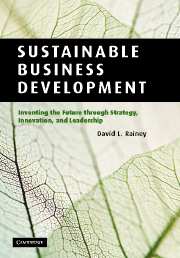Book contents
- Frontmatter
- Contents
- List of figures
- List of tables
- List of boxes
- List of abbreviations
- Acknowledgments
- Introduction
- Part I Enterprise thinking, the driving forces of change, and leadership
- Part II Innovation management, life cycle considerations, and insights
- 7 Sustainable technology management and development
- 8 Crafting and implementing sustainable business development programs
- 9 Life cycle thinking and framework
- 10 Formulation of life cycle assessment: initiation and inventory assessment
- 11 Implementation of life cycle assessment: impact and improvement assessments
- 12 Inventing the future through enterprise thinking and sustainable business development
- Glossary
- Select bibliography
- Index
- References
10 - Formulation of life cycle assessment: initiation and inventory assessment
from Part II - Innovation management, life cycle considerations, and insights
Published online by Cambridge University Press: 04 December 2009
- Frontmatter
- Contents
- List of figures
- List of tables
- List of boxes
- List of abbreviations
- Acknowledgments
- Introduction
- Part I Enterprise thinking, the driving forces of change, and leadership
- Part II Innovation management, life cycle considerations, and insights
- 7 Sustainable technology management and development
- 8 Crafting and implementing sustainable business development programs
- 9 Life cycle thinking and framework
- 10 Formulation of life cycle assessment: initiation and inventory assessment
- 11 Implementation of life cycle assessment: impact and improvement assessments
- 12 Inventing the future through enterprise thinking and sustainable business development
- Glossary
- Select bibliography
- Index
- References
Summary
Introduction
This chapter defines and examines LCA, a derivative construct of LCT that looks at products and processes to expose the full scope of their resource and energy utilization from cradle-to-grave and all the implications and impacts. While LCT explores the broad perspectives, LCA examines the particular, studying products and processes using rigorous quantitative and qualitative analyses to determine the inputs and outputs of materials and energy, causes and effects, problems and solutions. While standard LCA techniques are evolving, including ISO 14041, the constructs vary considerably, from streamlined versions focusing on the primary concerns to more elaborate holistic models that attempt to encapsulate the entire system.
LCA usually focuses on finding potential difficulties and curing the defects and burdens during the early phases of product and process development processes or during the early stages of product delivery. LCA is a means to obtain a significant amount of information about the whole system, from external suppliers to end-use customers and beyond. It can also be used to examine existing products and processes if there are significant problems that must be cured. If such efforts reveal the need for significant changes, the requisite improvement initiative may become an NPD program.
LCA is a rather radical break from the traditional business approaches of focusing on primary considerations and internal matters to a richer view of the full spectrum of the impacts and consequences of management decisions. It is action-oriented, identifying positive initiatives that can correct defects and burdens and/or improve products and processes.
- Type
- Chapter
- Information
- Sustainable Business DevelopmentInventing the Future Through Strategy, Innovation, and Leadership, pp. 552 - 605Publisher: Cambridge University PressPrint publication year: 2006



